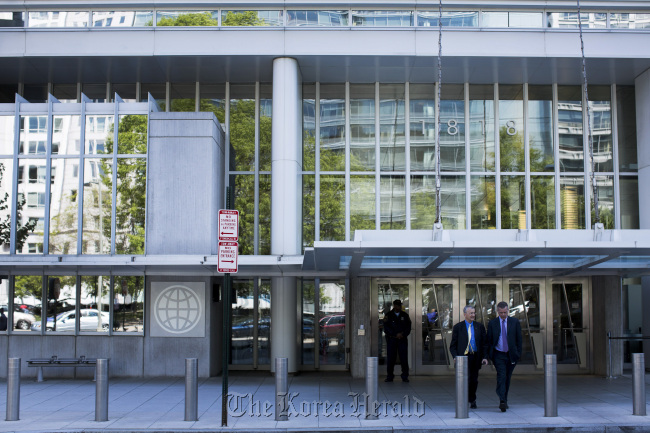WASHINGTON (AFP) ― The World Bank on Tuesday warned developing countries to boost their defenses against Europe’s debt crisis, predicting years of volatility in a flailing global economy.
In its semiannual report on worldwide economic conditions, the World Bank forecast the global economy would have “weak growth” of 2.5 percent in 2012, while developing countries’ pace would slow to 5.3 percent, the most sluggish rate in the past 10 years.
High-income countries should see a feeble 1.4 percent growth rate this year, burdened with a 0.3 percent contraction in the 17-nation eurozone as the bloc grapples with financial turmoil.
 |
The headquarters of the World Bank in Washington, D.C. (Bloomberg) |
“For all high-income countries, not just Europe, it will take many years to undo the damage that was done in the global financial crisis in 2008 or, more accurately, to address the problems that were created in the boom period before the crisis,” said Hans Timmer, head of Development Prospects at the Washington-based bank.
Developing countries have fewer means to weather shocks to their economies than they had in 2007, before the global financial crisis accelerated, the development lender said.
“Another serious financial crisis is a possibility,” Timmer said at a news briefing on the latest Global Economic Prospects report.
If high-income countries continue to grow even slowly, “it is still possible for developing countries to turn out very solid growth rates,” he said. “In case of a serious financial crisis, no developing country will be spared.”
The United States, the world’s largest economy, should have slightly slower growth of 2.1 percent, while Japan, recovering from the 2011 earthquake-tsunami disaster, should expand 2.4 percent, a sharp half point higher than believed six months ago.
China was projected to slow to 8.2 percent from the 8.4 percent pace seen in January.
The banks said that renewed uncertainty in the eurozone had led to a sharp deterioration in financial conditions in May.
That wiped out about seven percent of the value in stock markets in advanced and developing countries, hit commodity prices hard, and strengthened the dollar as investors sought a safe haven.
Andrew Burns, lead author of the report, said global capital flows fell 44 percent from April to May.
Even so, conditions in most developing countries have not deteriorated as much as they did in the 2011 fourth quarter, the 188-nation anti-poverty lender said.
Timmer said 60 percent of developing countries are now “close to overheating” after expanding spending and investment that insulated them from the European and U.S. downturns.
He urged developing countries to adjust their economic policies now to “move away from firefighting to strengthening your underlying growth potential.”
The report highlighted the need for developing countries to start re-investing in human and physical capital, such as infrastructure, to ensure sustainable growth.
The inexpensive and abundant capital that had driven the high growth rates of the past decade may no longer be available, the economists cautioned.
Burns stressed that developing countries should reduce their vulnerabilities where possible by lowering short-term debt levels and cutting budget deficits.
“Doing so will provide them with more leeway to loosen policy, should global conditions take a sharp turn for the worse,” Burns said.








